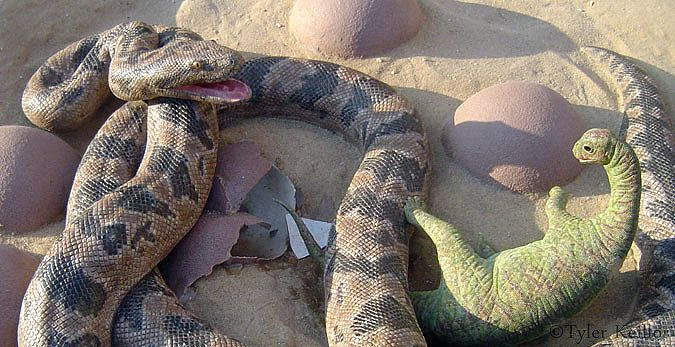4 Weird Fossils That Show Earth’s History, From Sex To Dinosaur Fights

We would know almost nothing about the ancient societies and environments that came before us without the numerous artifacts and creatures that were preserved over hundreds, thousands and millions of years. Some of these preserved pieces of world history are stranger than others, going beyond our classic idea of fossils being objects like neatly buried dinosaur skeletons.
Delicioussss meal
One example is the fossil of a snake eating a baby dinosaur that was found in western India in 2010. In a study in the journal PLOS Biology, scientists said the snake is about 11.5 feet long and is “coiled around an egg” right next to the remains of a hatchling. The little dinosaurs were sauropods, a large herbivore known for a long tail and a long neck that held up a small head, as well as thick bodies with elephant-like legs.
Because the way the snake is preserved reveals a behavior, it is known as an ethofossil. And enough of the remains were preserved for a sculptor to recreate the scene.
The fossil is 67 million years old, dropping the predatory snake into the dinosaur-dominated Cretaceous period just a couple of million years before the mass extinction event that killed them all off.
Sexy time turtles

Scientists reported a few years ago that they had found a fossil that could make you blush: two turtles having sex. The private moment from 47 million years ago was described in the journal Biology Letters as the “first record of copulating fossil vertebrates.”
The pair was dug up in Germany and even though the turtles died while mating, it wasn’t bad sex that killed them — according to the researchers, the site of their dirty deed was probably a lake within a volcanic crater, known as a maar, that had “inhabitable surface waters and a deadly abyss.” As the turtles got it on in the safe surface water, they sank down and “perished when their skin absorbed poisons while sinking into toxic layers.”
As the fossil reveals mating behavior in the prehistoric turtles, it is an ethofossil like the dinosaur-eating snake.
Fighting for their lives

Mother Nature taught a pair of dinosaurs a valuable lesson about violence. A velociraptor and a protoceratops were gripped in an intense battle 80 million years ago in the Gobi Desert when they were buried alive. As the New York Times describes it, the velociraptor had a claw of its foot in the neck of the protoceratops and was gripping its head, while the prey was biting the velociraptor’s arm, when a sand avalanche came rushing down on top of them. Heavy rain had collapsed the sand dune and helped preserve the fighting creatures.
Little swimmer

It’s rare to find a fossil that includes sperm, so it was interesting when scientists announced they had discovered sperm cells from 50 million years ago. According to a study in Biology Letters, the sperm came from the walls of a cocoon belonging to an annelid, a member of the family of segmented worms that include the earthworm and leeches. At the time, the researchers called it “the oldest fossil animal sperm yet known,” saying it predated the previous record-holder by 10 million years.
The cocoon fossil was found among rock samples in Antarctica.
“Because sperm cells are so short-lived and fragile, they are vanishingly rare in the fossil record,” first study author and paleontologist Benjamin Bomfleur told National Geographic.
© Copyright IBTimes 2025. All rights reserved.





















